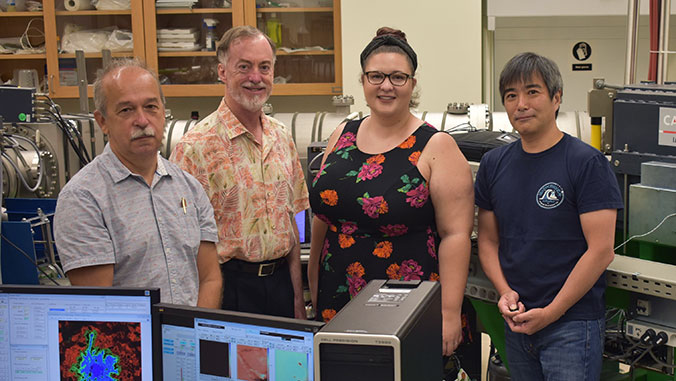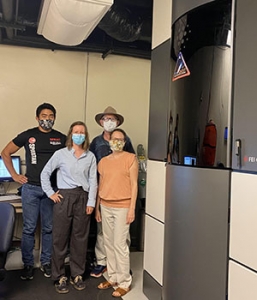
Planetary scientists at the University of Hawaiʻi at Mānoa are studying samples of the asteroid Ryugu, returned to Earth by the Hayabusa 2 spacecraft flown by the Japan Aerospace Exploration Agency. Ryugu is an ancient fragment of a larger asteroid that formed in the cloud of gas and dust that spawned our solar system. It is an intriguing type of asteroid that is rich in carbon, which is an element essential to life.
Hope Ishii, Elena Dobrica, John Bradley and Kenta Ohtaki, researchers at the Hawaiʻi Institute for Geophysics and Planetology (HIGP) in UH Mānoa’s School of Ocean and Earth Science and Technology, have already begun to analyze the treasured sample here in Hawaiʻi. Their Advanced Electron Microscopy Center (AEMC) in HIGP is home to a specialized scientific instrument called a transmission electron microscope which is capable of identifying minerals and the crystal structure in the sample at an incredible level of detail.

Scientists at the W.M. Keck Cosmochemistry Laboratory at HIGP have also been working on Ryugu samples. Researcher Kazuhide Nagashima, who is a deputy leader of the group that is making in situ, micron-scale analyses of the grains for their chemical and isotopic compositions, traveled to Japan to make the measurements. Nagashima and HIGP’s Keck Lab researchers Gary Huss and Alexander Krot will be receiving additional samples and analyzing them in their laboratory early next year using the secondary ion mass spectrometer.
“In addition to our long-standing collaborations with researchers in Japan, I believe we were invited to participate as members of the initial analysis team for the Ryugu sample because of international recognition of the expertise we have in transmission electron microscopy and secondary ion mass spectrometer analyses of extraterrestrial samples here at UH,” said Ishii, researcher and director of AEMC.
Combined, the analyses conducted by scientists at UH Mānoa and around the world will provide clues about the origin of the ancient substances contained in these rare samples.
This effort is an example of UH Mānoa’s goal of Excellence in Research: Advancing the Research and Creative Work Enterprise (PDF), one of four goals identified in the 2015–25 Strategic Plan (PDF), updated in December 2020.
–By Marcie Grabowski

